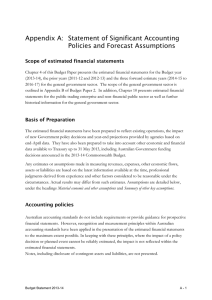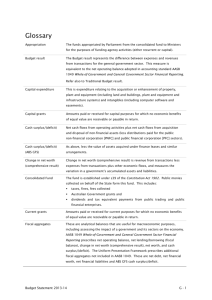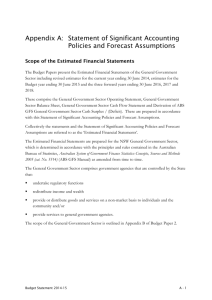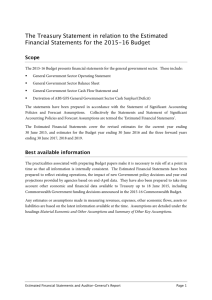2015-16 Budget Paper No. 1 - Appendix B2
advertisement
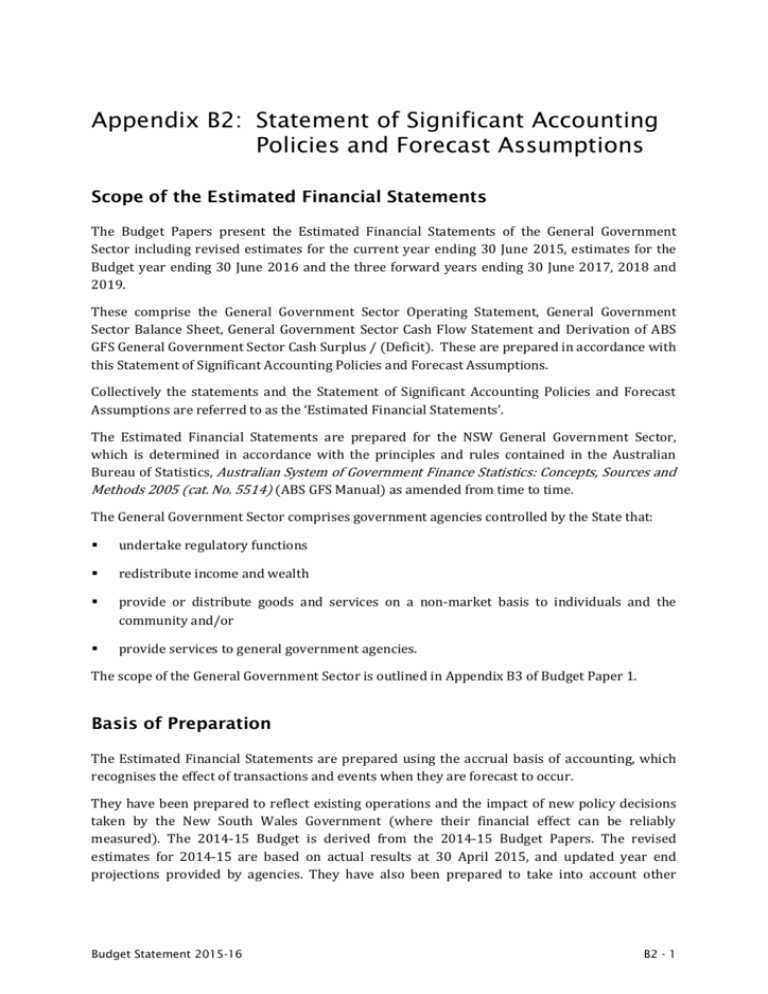
Appendix B2: Statement of Significant Accounting Policies and Forecast Assumptions Scope of the Estimated Financial Statements The Budget Papers present the Estimated Financial Statements of the General Government Sector including revised estimates for the current year ending 30 June 2015, estimates for the Budget year ending 30 June 2016 and the three forward years ending 30 June 2017, 2018 and 2019. These comprise the General Government Sector Operating Statement, General Government Sector Balance Sheet, General Government Sector Cash Flow Statement and Derivation of ABS GFS General Government Sector Cash Surplus / (Deficit). These are prepared in accordance with this Statement of Significant Accounting Policies and Forecast Assumptions. Collectively the statements and the Statement of Significant Accounting Policies and Forecast Assumptions are referred to as the ‘Estimated Financial Statements’. The Estimated Financial Statements are prepared for the NSW General Government Sector, which is determined in accordance with the principles and rules contained in the Australian Bureau of Statistics, Australian System of Government Finance Statistics: Concepts, Sources and Methods 2005 (cat. No. 5514) (ABS GFS Manual) as amended from time to time. The General Government Sector comprises government agencies controlled by the State that: undertake regulatory functions redistribute income and wealth provide or distribute goods and services on a non-market basis to individuals and the community and/or provide services to general government agencies. The scope of the General Government Sector is outlined in Appendix B3 of Budget Paper 1. Basis of Preparation The Estimated Financial Statements are prepared using the accrual basis of accounting, which recognises the effect of transactions and events when they are forecast to occur. They have been prepared to reflect existing operations and the impact of new policy decisions taken by the New South Wales Government (where their financial effect can be reliably measured). The 2014-15 Budget is derived from the 2014-15 Budget Papers. The revised estimates for 2014-15 are based on actual results at 30 April 2015, and updated year end projections provided by agencies. They have also been prepared to take into account other Budget Statement 2015-16 B2 - 1 economic and financial data available to Treasury up to 18 June 2015, including Commonwealth Government funding decisions announced in the 2015-16 Commonwealth Budget. In keeping with these principles, where the impact of a policy decision or planned event cannot be reliably estimated, the impact is not reflected within the Estimated Financial Statements (e.g. due to uncertainties regarding the timing and amount of future cash flows). Any estimates or assumptions made in measuring revenues, expenses, other economic flows, assets or liabilities are based on the latest information available at the time, professional judgments derived from experience and other factors considered to be reasonable under the circumstances. Actual results may differ from such estimates. Assumptions are detailed below, under the headings Material economic and other assumptions and Summary of other key assumptions. Accounting Policies Australian Accounting Standards do not include requirements or provide guidance on the preparation or presentation of prospective financial statements. However, recognition and measurement principles within Australian Accounting Standards have been applied in the presentation of the Estimated Financial Statements to the maximum extent possible. The Estimated Financial Statements do not include the impact of business asset transactions until they are finalised. The financial impact of future planned discontinuing operations or restructures are not recognised due to the commercial-in-confidence nature of the transactions. The Estimated Financial Statements adopt the accounting policies expected to be used in preparing general purpose financial statements for 2014-15. With the exception of those matters below, the policies are not materially different from those applied in the Total State Sector Accounts 2013-14. Note 1 of the Total State Sector Accounts 2013-14 sets out the significant accounting policies, including the principles of consolidation and the recognition and measurement policies for revenues, expenses, other economic flows, assets and liabilities. Change in Accounting Policies The following Australian Accounting Standards have been adopted in 2014-15, impacting on the State’s financial estimates as follows. Revisions to Standards relating to Consolidations, Joint Arrangements and Associates The State has adopted the following new and revised standards relating to consolidations, joint arrangements and associates on 1 July 2014: AASB 10 Consolidated Financial Statements; AASB 11 Joint Arrangements; AASB 12 Disclosure of Interests in Other Entities; AASB 127 Separate Financial Statements; and AASB 128 Investments in Associates and Joint Ventures. AASB 10 introduced a revised definition of control and provided several new principles in assessing whether control exists. AASB 11 requires joint arrangements to be accounted for based on their contractual arrangements, and distinguishes between joint operations and joint ventures. AASB 12 contains the disclosure requirements associated with ‘other entities’ (i.e. B2 - 2 Budget Statement 2015-16 subsidiaries, associates and joint ventures) that were previously located in AASB 127, 128 and 131 and Interpretations 112 and 113. The impact of any changes to control relationships on the Estimated Financial Statements, arising from these new and revised standards, is not expected to be significant. The General Government Sector does not consolidate Public Non-Financial Corporations and Public Financial Corporations that it controls on a line by line basis; and instead, recognises an equity investment in those entities and a gain or loss for changes in the carrying amount of the investment. Presentation of the Estimated Financial Statements The Estimated Financial Statements follow the presentation requirements for General Government Sector reporting contained in AASB 1049 Whole of Government and General Government Sector Financial Reporting. AASB 1049 harmonises generally accepted accounting principles (GAAP, i.e. Australian accounting standards) with Government Finance Statistics (GFS) principles in accordance with the GFS framework adopted by the Australian Bureau of Statistics. This occurs by requiring that: the statement of comprehensive income (referred to as the operating statement) classifies income and expenses as either transactions or other economic flows to be consistent with GFS principles, applied from a GAAP perspective The net operating balance (i.e. Budget result) is the net result of harmonised GFS-GAAP transactions for the general government sector. In the operating statement: the net operating balance (i.e. the Budget result) is the net result of income and expense transactions. It excludes other economic flows, which represent changes in the volume or value of assets or liabilities that do not arise from transactions with other entities and which are often outside the control of government. the operating result is the same under both the harmonised GFS-GAAP and pure GAAP presentations. Further, AASB 1049 requires: the financial statements adopt the recognition, measurement and disclosure requirements of GAAP where options exist in GAAP, the financial statements adopt the option that is aligned with GFS, to minimise differences between GAAP and GFS where options do not exist in GAAP and there is conflict between GAAP and GFS, GAAP prevails. Due to the prospective nature of the statements, detailed notes to the financial statements, including disclosure of contingent assets and liabilities, are not required to be presented within Budget Statement 2015-16 B2 - 3 the meaning of Australian Accounting Standards as outlined in Section 27A (5) of the Public Finance and Audit Act 1983. Each year ends on 30 June. All monetary amounts are presented in Australian dollars and rounded to the nearest million dollars ($m). Use of a zero (“0”) represents amounts rounded to zero. Use of three dots (“…”) represents nil amounts. Tables may not add in all instances due to rounding to the nearest million dollars. Presentation Changes There has been a minor presentation change within the Balance Sheet since the release of the 2014-15 Budget Papers to separately disclose ‘Financial Assets at Fair Value’ and ‘Other Financial Assets’ that are not recorded at fair value under the heading ‘Investments, Loans and Placements’. This presentation remains consistent with GAAP and GFS presentation requirements. Definitions Key technical terms, including fiscal aggregates, are defined in the Glossary to Budget Paper No 1. Material Economic and Other Assumptions The Estimated Financial Statements have been prepared using the material economic and other assumptions as set out in Table B2.1. Table B2.1: Key economic performance assumptions (a) 2013- 14 2014- 15 Outcomes Forecasts 2015- 16 Forecasts 2016- 17 2017- 18 and 2018- 19 (b) Forecasts Projections New South Wales Real state final demand 2.7 3¼ 3½ 3½ Real gross state product 2.1 2½ 3 3 2¾ Employment 0.6 1¼ 1¾ 1¾ 1¼ 5.7 6 5¾ 5¾ 2.5 1¾ 2½ 2¾ 2.8 1¾ 2½ 2¾ 2.5 2¼ 2½ 2¾ 3.1 4 4 4¾ Unemployment rate (c) (d) Sydney CPI - through the year to June quarter (d) Wage price index Nominal Gross State Product (e) 2½ 3½ (a) Per cent change, year average, unless otherwise indicated. (b) Average across 2017-18 and 2018-19. (c) Year average, per cent. (d) 2014-15 includes a ¾ of a percentage point detraction from the abolition of the carbon tax. 2014-15 to 2016-17 include a ¼ of a percentage point contribution from tobacco excise increases. (e) Nominal GSP measures the value of production whereas real GSP measures the volume of production. The difference is a measure of the average change in prices for goods and services produced. Source: ABS 5206.0, 5220.0, 6202.0, 6401.0, 6345.0 and Treasury B2 - 4 Budget Statement 2015-16 Summary of Other Key Assumptions The following section outlines the other key assumptions used in the preparation of the Estimated Financial Statements. The summary takes into account materiality in relation to the General Government Sector’s overall financial position and sensitivity to changes in key economic assumptions. Notwithstanding these key assumptions, agency finance officers apply appropriate professional judgement in determining estimated financial information. Revenues from Transactions Taxation Taxation revenue is forecast by assessing economic and other factors that influence the various taxation bases. For example for payroll tax, this involves an assessment of the outlook for employment and wages. Forecasts of government guarantee fees take into account an assessment of the level of debt of public non-financial corporations and their credit rating differential compared with the State as a whole. The forecasts of taxation revenue also involve the analysis of historical information and relationships (using econometric and other statistical methods) and consultation with relevant government agencies. Grants revenue Forecast grants from the Australian Government are based on the latest available information from the Australian Government and projections of timing of payments at the time of preparation of the Budget. This takes into account the conditions, payment timetable and escalation factors relevant to each type of grant. The Goods and Services Tax (GST) grants are forecast based on estimates of the national GST pool by the Australian Government. For 2015-16, the GST forecast is based on the assessed relativity for New South Wales in 2015-16 and the Australian Government’s population projections. The assessed relativity is the average of the past three years annual per capita relativities (2011-12, 2012-13 and 2013-14) as published by the Commonwealth Grants Commission. After 2015-16, the State’s share of GST is based on assessed relativities in a particular year and the Australian Government’s population and GST pool projections. The forecast per capita annual relativities are based on the projected relative fiscal capacity of New South Wales compared to other States and Territories. Sales of goods and services Revenue from the sale of goods and services is forecast taking into account factors including estimates of changes in demand for services provided or expected unit price variations based on proposed fee increases imposed by general government agencies and/or indexation. Budget Statement 2015-16 B2 - 5 Dividend and income tax equivalents from other sectors Dividend and income tax equivalent revenues are estimated by public financial and non-financial corporations based on expected profitability and the agreed dividend policy at the time of the Budget. Fines, regulatory fees and other revenues Fines, regulatory fees and other revenues include estimates of fines issues by the Courts, estimated traffic infringement fines, estimated revenue from enforcement orders, regulatory fees, contributions and royalty revenue for which estimates are based on assessments of coal volumes and prices and the Australian dollar exchange rate. Other revenue forecasts are adjusted for indexation where appropriate. Expenses from Transactions Employee expenses Employee expenses are forecast based on expected staffing profiles, current salaries, conditions and on-costs. Employee expenses are adjusted over the forecast period for approved wage agreements. Beyond the period of the agreements, allowance is made for further adjustments consistent with the Government’s wages policy at a net cost of 2.5 per cent per annum inclusive of scheduled increases in the superannuation guarantee levy. The forecasts for employee expenses also reflect the impact of new approved initiatives and required efficiency savings. Superannuation expense (and liabilities) Superannuation expenses comprise: for the defined contribution plan, the forecast accrued contribution for the period, and for defined benefit plans, the forecast service cost and the net interest expense. This excludes the re-measurements, (i.e. actuarial gains and losses and return on plan assets excluding the gross interest income) which are classified as ‘other economic flows – other comprehensive income’. Superannuation expenses for defined contribution plans are based on assumptions regarding future salaries and contribution rates. Superannuation expenses for defined benefit plans are estimated based on actuarial advice applying the long-term Government Bond yield as at 30 June in the prior year to the opening value of net liabilities (gross superannuation liabilities less assets), less benefit payments at the mid-point of the contribution year, plus any accruing liability for the year. Forecasts of defined benefit superannuation liabilities are based on actuarial estimates of cash flows for the various defined benefit superannuation schemes discounted using a nominal long-term Commonwealth Government bond yield as at 30 June. Gross liability estimates are B2 - 6 Budget Statement 2015-16 based on a number of demographic and financial assumptions. The major financial assumptions used for the budget and forward estimates period are outlined in the table below. The table below sets out the major financial assumptions used to estimate the superannuation expense and liability in respect of defined benefit superannuation for the budget and forward estimates period. Table B2.2: Superannuation Assumptions – Pooled Fund / State Super Schemes 2014-15 % 2015-16 % 2016-17 % 2017-18 % 2018-19 % Liability discount rate 2.77 3.02 3.79 4.33 4.55 Expected return on investments 15.3 8.60 8.60 8.60 8.60 2.25 2.50 2.50 2.50 2.50 2.25 2.50 2.50 2.50 2.50 1.50 2.50 2.75 2.75 2.50 Expected salary increases(a) - SSS and SASS Members - PSS Members (b) (b) Expected rate of CPI (a) Taking the increased Superannuation Guarantee Contribution into account, total remuneration will increase by 2.5 per cent. (b) SSS – State Superannuation Scheme, SASS – State Authorities Superannuation Scheme, PSS – Police Superannuation Scheme Depreciation and amortisation Property, plant and equipment is depreciated (net of its residual value) over its useful life. Depreciation is generally allocated on a straight-line basis. Depreciation is forecast on the basis of known asset carrying valuations, the expected economic life of assets, assumed new asset investment and asset sales programs. The expense is based on the assumption that there will be no change in depreciation rates over the forecast period, but includes the estimated impact of the current and future revaluation of assets over the forecast period. The depreciation expense may also be impacted by future changes in useful lives, carrying value, residual value or valuation methodology. Certain heritage assets, including original artworks and collections and heritage buildings, may not have a limited useful life because appropriate custodial and preservation policies are adopted. Such assets are not subject to depreciation. Land is not a depreciable asset. Intangible assets with finite lives are amortised under the straight line method. Intangible assets with an indefinite life are not amortised, but tested for impairment annually. Interest expense The forecasts for the interest expenses are based on: payments required on the current general government sector debt, Budget Statement 2015-16 B2 - 7 expected payments on any new borrowings (including any refinancing of existing borrowings) required to finance general government activities based on forward contracts for NSW Treasury Corporation bonds, and the unwinding of discounts on non-employee provisions. Other operating expenses Other operating expenses mainly represent the day-to-day running costs incurred in the normal operations of agencies and include the cost of supplies and services. They are forecast by applying appropriate economic parameters and known activity changes, including planned changes in the method of service delivery and the application of government policy. Other operating expenses also reflect the impact of government efficiency strategies, such as efficiency dividends. Grants and subsidies expense Grant and subsidy expenses generally comprise cash contributions to local government authorities and non-government organisations. For the general government sector they include grants and subsidies paid to the Public Non-Financial Corporation and Public Financial Corporations sectors. The forecast grant payments are determined taking into account current and past policy decisions, the forecast payment schedules and escalation factors relevant to each type of grant. Other Economic Flows Revaluations The estimates are based on an examination and extrapolation of historical trends in the valuation of non-financial physical assets. The forward estimates include the estimated impact of revaluations of non-financial physical assets. Superannuation actuarial gains / losses The forecast gain or loss on defined benefit superannuation is based on the revised estimates of the margin of forecast fund earnings in excess of the expected discount rate. Net gain on equity investments in other sector entities The gain or loss on equity investments in other sector entities is based on estimates of the public financial corporation and public non-financial corporation sectors’ forward comprehensive results adjusted for transactions with owners. The underlying management estimates of future comprehensive results are based on current Statements of Corporate Intent. Future distributions to owners are based on the Treasury Commercial Policy Framework. B2 - 8 Budget Statement 2015-16 Assets Land and buildings, plant and equipment, and infrastructure The estimates of non-financial physical assets over the forecast period are at fair value and take into account planned acquisitions, disposals, and the impact of depreciation and revaluations. New investments in assets are valued at the forecast purchase price and, where appropriate, recognised progressively over the estimated construction period. The forward estimates include the estimated impact of revaluations of non-financial physical assets. These estimates are based on an examination of expected cost trends. The Estimated Financial Statements also include provisions for future capital expenditure. These include agency estimates of approved projects and future new works held within agencies, as well as a central estimate for future new works still to be approved at the agency level. The central estimate for future new works is based upon historical trends. Liabilities Borrowings Estimates for borrowings are based on current debt levels, amortisation of any premiums or discounts and the cash flows expected to be required to fund future government activities. Employee provisions Employee provisions are forecast based on expected staffing profiles and current salaries, conditions and on-costs. For the forecast period, employee benefits are adjusted for approved wage agreements. Beyond the period of the agreements, allowance is made for further adjustments consistent with the Government’s wages policy at a net cost of 2.5 per cent per annum inclusive of scheduled increases in the superannuation guarantee levy. The forecasts for employee expenses also reflect the impact of new initiatives and required efficiency savings. Superannuation provisions Refer to superannuation expense (above) for information on assumptions that also impact the measurement of the superannuation provisions. Other provisions Other provisions include the State’s obligations for several insurance schemes. To estimate future claim liabilities, actuarial assumptions have been applied for future claims to be incurred, claim payments, inflation and liability discount rates. Actual liabilities may differ from estimates. Budget Statement 2015-16 B2 - 9
